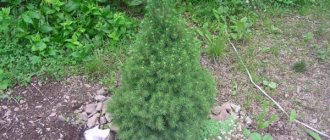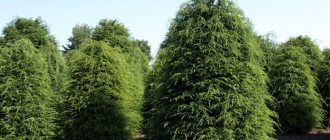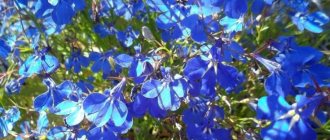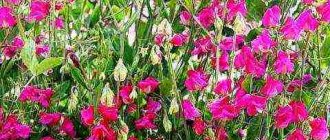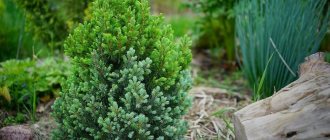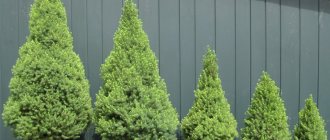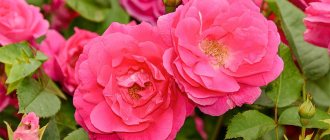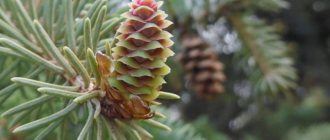Canadian spruce: general information
“Any Canadian spruce – daisy, alberta, conica – is a long-liver: it can stand for 500 years.”
In nature, this type of spruce tree is tall. The height of individual individuals can reach up to 30 meters. Of course, you can’t plant such giants along an alley, but dwarf Canadian spruce trees would be quite appropriate in this case. No matter how tall the tree is, it will always be distinguished by the correct conical shape of the crown, and this in itself has a decorative value. The fastest growth of seedlings is observed in the first decade. Young trees have raised paws and a dense crown. In old ones, the branches droop slightly downwards.
Canadian spruce seedlings
The needles of the plants have a bluish tint, which gave rise to another name for foreign guests of our gardens - Canadian blue spruce.
The needles, although short, are quite prickly. Cones on dwarf spruce trees appear once every decade. They have a very beautiful elongated shape, but bear little resemblance to the cones of the common spruce, and the photo confirms this.
Any Canadian spruce - daisy, alberta, konica - is a long-liver: it can stand for 500 years. This type of tree is winter-hardy and drought-resistant.
Canadian spruce is winter-hardy and drought-resistant.
Today, our landscapes are decorated with about 20 subspecies of dwarf spruce trees of Canadian origin.
Botanical description
White spruce is a fairly tall tree, reaching up to fifty meters in height. The size of the trunk is about one meter in diameter. Dense branches form a dense, cone-shaped crown. In young trees, the branches are directed upward at an angle, while in mature trees they are directed straight down. The bark of the trunk can be smooth or covered with small gray-brown scales. The shoots of the plant are usually much lighter than old trees, and sometimes they are completely white.
The buds are not resinous, light brown, 3-6 mm in length. Coniferous needles grow from 8 to 18 mm in length and 1.5 mm in width, and have a tetrahedron shape in cross-section. The needles are green on all sides with a bluish tint. The needles stay on the tree for 5-7 years , and in some cases up to 11 years. The cones are cylindrical, ovoid, up to 7 cm long and 1.5-2.5 cm wide. The scales of the cones are thin and soft, solid at the top.
The seeds are small and have a light wing that is three times their length. Spruce is sometimes found in the mountains at an altitude of 1.5 km. The evergreen tree tolerates severe frosts well and is indifferent to drought. It grows on literally all existing types of soil. Unlike Norway spruce, it tolerates gas pollution and smoke in the atmosphere well. In culture, this species is recommended for both single and group plantings.
Varietal diversity
Spruce echiniformis
A dwarf plant with a bushy form. The crown is cushion-shaped, can be flat or round. The legs are short, their growth is dense, due to which young individuals have an original spherical appearance. Dwarf Echiniformis does not grow higher than 60 cm and can be up to a meter in diameter. Like the decorative conic spruce, Echiniformis grows slowly, giving no more than 2 cm of growth per year. Young shoots are light brown, shiny, elastic. They are overgrown with needles radially. The needles are narrow, thin and short. They have a bluish-greenish color. The root system, although superficial, is very well developed.
Spruce echiniformis
Canadian spruce Echiniformis prefers to grow in sunny areas, but if necessary, it can adapt well to partial shade. The plant is not picky when it comes to soil. It grows equally well in both acidic and alkaline soils. The main condition is that this soil should be:
1. Sufficiently moisturized.
2. Rich in nutrients.
3. Fresh.
The advantages of Canadian spruce of this variety include absolute resistance to air pollution, temperature changes, including frosts inherent in our climate.
Spruce echiniformis is resistant to temperature changes
Scope of application
Dwarf spruce echiniformis is an excellent solution for decoration:
- alpine slides;
- rocky gardens;
- rockeries;
- landscapes in oriental style.
Spruce echiniformis is suitable for decorating alpine slides
A cushion-shaped plant that thrives in containers can decorate the entrance area of restaurants, administrative buildings, and cottages.
Canadian daisy spruce
This dwarf spruce is an excellent mini-copy of the classic Canadian conika. The height of trees of this variety ranges from 0.8 to 1 meter. For landscape design, dwarf daisy spruce is chosen for its beautiful cone-shaped crown and unusual coniferous cover. This is the only species of Canadian spruce whose needle color adapts to environmental conditions. Its crown can be light green, like the common spruce in the photo, or golden yellow, or even white. The needles themselves are short and very delicate, soft to the touch.
Canadian daisy spruce
As for growth, the Canadian daisy spruce feels great both in the sun and in partial shade, but in the second case you can forget about the variegated color of the tree. The Daisy variety loves well-drained fertile soils with moderate humidity.
Daisy spruce prefers fertile soil
Scope of application
Like dwarf spruce echiniformis, daisy is used in rock gardens. It is an ideal solution for decorating landscapes of small cottages. The motley baby will become a real pearl of the garden plot, regardless of its size and design style. It is the Canadian Echiniformis that is recommended to be planted on the rocky banks of the stream. It successfully coexists with erikas, heathers, and ornamental bushes.
Daisy spruce is ideal for decorating a rock garden
Alberta spruce
Our gardeners liked the pretty Canadian spruce because of its rounded shape. Dwarf Alberta is incredibly similar to a fluffy ball, which makes it possible to decorate with it not only rock gardens and rock gardens, as is the case with the Canadian daisy and echiniformis spruce, but also gardens interpreted in an oriental style. Moreover, the Alberta variety retains its spherical crown shape voluntarily, without regular haircuts.
Alberta spruce
Spruce grows slowly. By the age of ten, its height still does not exceed 0.7 m. The diameter of the crown varies from 0.4 to 1 meter. Alberta spruce produces short shoots. Its needles are thin and densely growing. The needles, up to a centimeter long, have a light green color, like the common spruce in the photo, but are more decorative and less prickly.
The plant is not picky about soil. It grows well on any enriched and moist soil, regardless of its acid-base level. This variety of Canadian spruce does not have to be planted in open ground. It can be kept in pots. The tree loves light. Under the sun's rays it forms a dense and brightly colored crown. If necessary, can live in partial shade.
Alberta spruce photophilous
Scope of application
Dense, globular dwarf Alberta spruces can be found in rock landscape landscaping projects. No less popular than the Canadian daisy spruce, it is also used in the arrangement of rock gardens. Dwarf Alberta itself can become a curiosity in the garden, so it is not necessary to include it only in group plantings. Like the Canadian spruce, globular spruce, planted in containers, can decorate entrances to cottages, restaurants and any official buildings.
Alberta spruce can be kept in pots
Spruce glauka konica
It was her extraordinary appearance that brought this little beauty into the world of gardening. Today, this variety of spruce is a component of landscapes in all corners of the planet. It has taken root well in our harsh conditions. The conika spruce, distinguished by its winter hardiness, can survive wherever the common spruce with photo grows. The small size became a big advantage of the variety, allowing the tree to settle in the most modest areas. The average height of the Glauka Konika spruce is about a meter, although with good maintenance it can stretch to all three. The narrow, dense crown has a cone-shaped shape. The needles have a beautiful bluish-green tint. It is soft, thin and short.
Spruce glauka konica
Konica's roots are compact. The system is represented by a weakly expressed, rod-type process, from which a network of thin lateral branches extends.
Unlike dwarf Canadian spruces, blue conika is shade-tolerant, so it can easily grow near a fence, in areas behind the house. The open areas of the site are not for her. The needles fade in the sun. The plant especially suffers from burns in the event of sudden spring warming and in winters with little snow.
Spruce gray conika is shade-tolerant
In addition to sunbathing, Glauka Konika spruce does not react well to drafts. In general, to plant it you need to choose a closed, quiet, shaded corner.
What else doesn’t the Canadian gray Konika like? Like all representatives of spruce trees, it does not tolerate drought, so in the absence of rain for a long time, it must be provided with regular watering.
Scope of application
In landscape design, conika spruce is good in all forms. It perfectly decorates lawns and group plantings. Slow growth does not allow the variety to be used in flower beds, but once the tree reaches medium height, it will fit perfectly into mixborders.
Gray conika spruce fits perfectly into mixborders.
Spruce pendula
This beauty was given to us by the Serbian forests. Slow growing with a narrow weeping crown type, Pendula is the complete opposite of the low-growing Canadian Alberta, Daisy spruces. Giving only 10 cm of annual growth, by the age of 30 it can have a height of ten meters. The needles of the pendula are dark green. The shoots are like those of the common spruce in the photo - flexible and lowered along the trunk. The tree is unpretentious. It reacts equally well to both heat and cold. It is one of the frost-resistant species.
Pendula spruce is one of the frost-resistant species.
Easily adapts to areas with high levels of gas and smoke. Pendula spruce is unpretentious to the type of soil. The only thing that is contraindicated for her is waterlogging. The plant is highly resistant to diseases and is practically too tough for pests.
Pendula spruce is highly disease resistant
Scope of application
Indispensable in group plantings. It looks no less original when planted alone. Pendula spruce will be a welcome guest in gardens where a non-standard landscape solution is envisaged.
Pendula spruce is suitable for designing non-standard landscapes
It is also recommended for use in mixed compositions.
Diseases and pests
Glauka spruce is characterized by fairly high resistance to pests and diseases. However, if the area is poorly ventilated, in rainy weather or when moisture stagnates in the soil, the plant can be affected by a fungal disease: brown schute, fusarium. It is necessary to treat the tree with a fungicidal preparation, for example, Fundazol, Topaz, etc., as soon as possible.
For such a crop, the greatest danger is posed by gall and spruce aphids, spider mites and leaf rollers. To combat them, acaricidal and insecticidal agents are used, for example: Konfidor, Aktaru, Fitoverm. To achieve the result, you will need several treatments with the drug with a break of 1 week. For preventive purposes, at the beginning of spring, the tree is treated with a one percent Bordeaux mixture.
Selection of seedlings
Canadian spruce seedlings should be purchased from special nurseries. There are good specimens of plants from professional gardeners. Before making a choice, look for assorted specimens of gray conica, daisy, pendula, echiniformis, and common spruces in the photo in the gallery and see what condition the seedlings are in.
What to pay attention to:
1. Condition of the needles. The crown should be thick, shiny, without areas of dried needles.
2. Soil mixture in a container. It should not be overdried or cracked. Roots protruding from the ground are also a bad sign. Their presence indicates a size discrepancy in the flowerpot and inadequate development of the seedling.
3. Roots. They are inspected when purchasing dwarf spruce trees that are being dug up. The root system must be absolutely intact, without the slightest damage.
Carefully inspect the seedlings before purchasing
Where to plant
All varieties of Canadian spruce are light-loving, but this does not mean that they cannot be planted in partial shade. Young specimens respond especially well to shading, since their delicate needles often get burned in the sun. But you shouldn’t send Canadian blue spruce trees into dense shade. In the complete absence of sun, seedlings practically do not grow and lose the beauty of the natural color of the needles. You can see where to plant dwarf spruce trees in the photo.
All varieties of Canadian spruce are light-loving
These specimens are good for framing garden paths, creating natural fences, and landscape compositions. Tall Canadian and Norway spruce trees also have a place in the garden. With their help you can create a rather picturesque landscape.
Framing the path with dwarf Canadian spruce
Spreading
In nature, Canadian spruce is most widespread in the northern part of North America. Here it is found over a wide area from northern Montana to northern Alaska. Today, cultivated varieties with spectacular needles are very popular in European countries. They often decorate private garden plots and public parks.
Subtleties of landing
The soil
Canadian spruce should be planted in loamy soil with a high percentage of humus. It should not be limed. Spruce prefers moist, but not swampy soil, so you will have to take care of organizing drainage.
When to plant
When to carry out the planting procedure directly depends on the quality and variety of planting material. Provided that the dwarf spruce seedling is in a container, you will not have any special restrictions on planting time. You can transfer it to open ground at any time convenient for you, from early spring to late autumn.
Seedlings in containers are planted from early spring to late autumn
If the seedlings were ate coniki or Norway spruce dug up in the nursery, then they will have to be planted in late April - early May. The young tree must have time to take root before winter arrives.
Seedlings from the nursery are planted in late April - early May
How to plant
The start of the landing procedure is traditional. A planting hole is dug under the seedling. It is made approximately one and a half times larger than the earthen ball in the roots.
Planting pit for Canadian spruce
Spruce roots are abundantly moistened. While they are saturated with water, the soil composition is prepared. You can buy it ready-made or make it yourself by mixing garden soil with compost.
Drainage is laid at the bottom of the pit. To create this layer, you can use broken bricks, small stones, and expanded clay.
A little earth is poured over the drainage and a Canadian spruce seedling is sent into the prepared hole.
If the plant was previously in a container, then they use the transshipment planting method, that is, they remove it from the container along with the existing soil without clearing the root system of it. It is better to cover the seedlings of Glauca conica and pendula with soil in stages, slightly compacting and watering each portion sent into the hole.
When filling the roots, make sure that the root collar does not get under the layer of soil.
Planting ends with abundant watering and mulching of the tree trunk circle, which is done with peat or the same compost.
Canadian spruce planting scheme
A planted dwarf or common spruce, even if it belongs to the light-loving category, must be shaded. Burlap provides the best protection from the sun. If you don’t have such material at hand, replace it with kraft paper or a piece of thick fabric of any quality.
You can view the progress of the planting process of Norway spruce, Canada spruce and pendula in photos or videos on specialized websites.
Reproduction methods
Reproduction of Glauka spruce in nurseries is carried out in 3 ways: cuttings, seeds and grafting. Thanks to grafting, breeders manage to obtain the most spectacular varieties of blue spruce on a standard or Glauka spruce. However, only specialists can vaccinate correctly, and even they regularly lose some of the planting material.
Seed collection is carried out in the autumn, using fully ripe cones. They are then subjected to stratification for two months. Then the seeds are sown in peat to a depth of about 20 mm. The crops are placed in a mini-greenhouse and provided with a large amount of light. When the first seedlings appear, the shelter needs to be removed. After which they are grown in a greenhouse for three years. After this, you can transplant the seedling to a permanent place.
To take cuttings, choose a plant that is more than eight years old. To do this, cut off the tops of the shoots with a piece of bark, and the length of the segment should be about 10 centimeters. The lower part of the cutting is treated with a means that stimulates root growth, after which it is planted in a substrate of peat, sand and perlite. Next, the plantings are placed in a mini-greenhouse, located in partial shade and warmth. After the roots grow, the seedling is left in the greenhouse for another 4 years. Then it is planted in a permanent place.
REPRODUCTION OF BLUE SPRUCE. The simplest but most effective way to propagate blue spruce is by cuttings.
Dwarf spruce: subtleties of care
“Information about the drought resistance of conica, daisy, echiniformis, and alberta spruce trees refers exclusively to mature plants whose root systems are strong and well developed.”
A beautiful Canadian spruce can only be grown with proper and regular care.
Watering
Information about the drought resistance of conica, daisy, echiniformis, and alberta spruce trees refers exclusively to mature plants whose root system is strong and well developed. Young growth will require not very frequent, but very abundant watering. Up to ten liters of water should be poured under each specimen.
Young Canada spruce requires regular watering
Particular attention is paid to the irrigation issue in the autumn, as this is part of the preparation for wintering. A common cause of death of dwarf spruce trees during wintering is not frost, but a lack of moisture reserves.
And one more thing: all varieties of Canadian spruce respond very well to crown irrigation. On dry days you should not forget about this.
Loosening
When caring for spruce trees, this procedure is as important as adequate watering. It should be done as the soil dries in the tree trunk area. Loosening is carried out with caution, since most dwarf and common Canadian spruce trees have a very superficial root system.
Mulching
This procedure for caring for spruce trees is aimed at preserving moisture and maintaining a stable temperature in the root zone. Mulch is also good for weed control. Under mulch, earthworms are very comfortable; they reproduce there with pleasure, which has a good effect on the condition of the soil. It is constantly loosened and the roots have sufficient ventilation.
Mulching the soil
The best materials for mulch are:
- bark;
- wood chips;
- sawdust;
- peat.
The optimal layer of mulch is 5 cm.
Top dressing
Canadian spruce is not whimsical and, in principle, does not require mandatory feeding, but still, if you want to see the plants in your garden beautiful and strong, they should be fed with special compounds. This is done in any spring month.
In addition to balanced mineral fertilizers, when caring for Canadian spruce trees, conica, daisy, alberta and others, it is worth using organic matter such as compost.
Canadian spruce should be nourished with special compounds.
When choosing a fertilizer, make sure that it does not contain many nitrogen compounds. Nitrogen is detrimental to any representative of the Canadian blue spruce and Pendula spruce.
Crown formation
Most dwarf spruces initially have more than decorative forms. They can boast of the natural correctness of their formation and density, but they still cannot do without slight correction. It is recommended to prune once a season. Basically, the procedure is sanitary in nature. During this process, damaged and dried branches are removed. Sometimes it is necessary to shorten several shoots that have come forward. This is basically where it all ends.
Once a season, sanitary pruning is carried out
Winter care
The beginning of snow melting will be a signal for the Canadian spruce trees in your garden to be freed from snow. With dwarf spruce trees this will not be as easy as with large, spreading trees. The snowdrifts packed inside the dense crown cannot be shaken off with a slight movement, as with ordinary spruce trees. Here you will have to try to get them out of there.
Snow cannot be left for the following reason. Melted snowdrifts form something like an ice lens, through which the active spring sun will simply burn out the inside of the crown.
If the ice is already fixed inside the coniferous ball of the Canadian Alberta spruce and it is impossible to destroy it without damaging the needles, you will have to “decorate” the optics with a layer of earth or black peat. This will allow the ice to melt away painlessly for the plant on the first warm day.
Spruce in the house
If you think that unpretentious dwarf Canadian spruce trees can decorate home windowsills, then you are very mistaken. The plant is absolutely not intended for keeping at home. The maximum period of stay in the apartment is 14 days. Then representatives of Canadian blue spruces must be planted in the ground or placed outside directly in a container. Otherwise, the spruce will begin to wither and eventually die.
